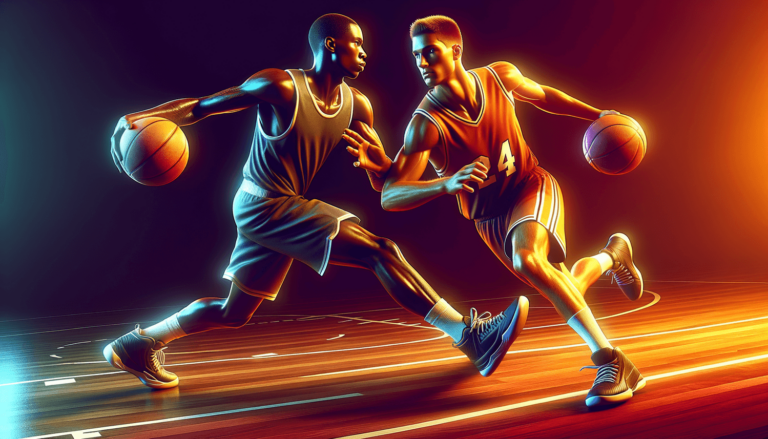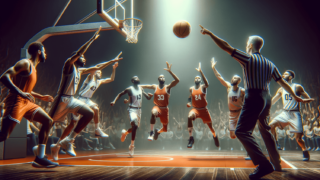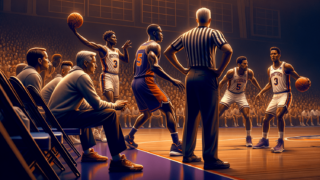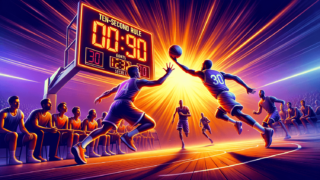
If you’re looking to delve into the fascinating world of basketball, understanding the fundamentals is essential, and one crucial rule that can change the course of any game is the charge. A charge in basketball encompasses the perfect blend of strategy and athleticism, as it tests a player’s ability to make split-second decisions while in the heat of the action. In this comprehensive blog post, we’ll uncover every facet of this intriguing maneuver, from the core concept to its execution, in pursuit of adding one more valuable piece to your ever-growing basketball knowledge base. So fasten your seatbelt and let’s tip-off our exciting journey into the world of charges in basketball!
What Is a Charge in Basketball?
A charge in basketball occurs when an offensive player with the ball makes significant contact with a stationary defensive player who has established a legal guarding position. By successfully taking a charge, the defensive player draws a personal foul on the offensive player, resulting in a turnover and possession for the defensive team.
Understanding the Art of Taking a Charge
While charging might not garner the same attention as high-flying dunks or buzzer-beating shots, it remains a fundamental aspect of basketball. It requires skill, physicality, and, most importantly, a strong understanding of the game. To genuinely appreciate the significance of a charge in basketball, we must explore its strategic implications, the elements that constitute a successful charge, and some helpful tips to get better at executing this game-changing maneuver.
The Strategic Importance of Charges
In the realm of basketball, charging plays a critical role in turning the game’s momentum in your favor. Basketball teams often utilize charging as a defensive strategy to disrupt the rhythm of the opposing team’s offense, forcing turnovers and frustrating opposing players. It also demonstrates a player’s commitment to their team and willingness to sacrifice their body for the greater good of their squad.
Creating Turnovers and Foul Trouble
Successfully taking a charge creates an opportunity for the defensive team to regain possession of the ball, immediately halting the offensive team’s chances of scoring. Just as crucial, a charge results in a personal foul for the offensive player, which can accumulate over a game and potentially lead to that player’s disqualification. This fact makes charges highly valuable when faced with an opponent who has a significant offensive impact on the game, as putting them in foul trouble limits their overall effectiveness.
Legal Guarding Position: The Key to a Successful Charge
To execute a charge effectively, a defensive player must establish a legal guarding position before any contact occurs. This position is critical in determining whether the referees will call a charge on the offensive player or a blocking foul on the defender.
Feet and Body Placement
A legal guarding position involves a defensive player having both feet set on the floor and their torso facing the offensive player with the ball. The player’s stance should remain wide enough to retain balance but not so wide that it impedes the offensive player’s movement. Proper body placement and anticipation of where the offensive player will move can greatly increase the chances of successfully drawing a charge.
Anticipating the Offensive Player’s Move
Taking a charge often hinges on the defender’s ability to read the offensive player’s movements and anticipate where they will go. By positioning themselves in the path of the opponent, the defensive player can force the offensive player to make a decision: take the contact and risk a charging foul, or alter their course, potentially leaving them off-balance and more susceptible to mistakes.
Perfecting the Charge Execution
To master the art of taking charges, one must develop physical skills and a deep understanding of basketball. Employing the following tips can elevate a player’s ability to draw charges and become an effective defensive force for their team.
Sharpen Your Reflexes and Timing
Reflexes and timing are crucial in taking charges. To beat the offensive player to the spot and establish a legal guarding position, a defender must react quickly and decisively. Engaging in reflex training, such as reaction drills or plyometrics, can improve a player’s ability to move swiftly into position and effectively draw charges.
Emphasize Lower Body Strength
Lower body strength is vital for maintaining balance and absorbing contact when taking a charge. Strengthening exercises, such as squats, lunges, and leg presses, can help basketball players build the robust lower body foundation necessary for successful charge-taking.
Learn to Protect Yourself
While there’s no way to completely eliminate the risk of injury when taking a charge in basketball, learning how to protect yourself when falling can minimize the chances of getting hurt. Falling techniques, such as tucking in the chin, adopting a slightly curled posture, and using arms to cushion the fall, can help players avoid injuries and adverse long-term effects.
Study Your Opponents
Knowledge can often be the determining factor between a successful charge and a blocking foul. Being well-versed in your opponents’ tendencies and style of play can give defenders an edge when anticipating movements and positioning themselves effectively. Studying game footage and understanding the strategies your opponents use can pay significant dividends in your quest to become a charge-master.
Distinguished Charge-Takers in Basketball History
Many accomplished basketball players have made an indelible mark on the game with their exceptional charge-taking abilities. Here are some noteworthy names who’ve transformed their defensive prowess into an art form:
Shane Battier
A former NBA player and two-time NBA champion with the Miami Heat, Shane Battier was widely renowned for his knack for drawing charges. Battier’s defensive skills, combined with his high basketball intelligence, allowed him to excel in anticipating opponents’ moves and executing charging fouls to the team’s advantage.
Dennis Rodman
Dennis Rodman, a Hall of Fame inductee, five-time NBA champion, and two-time NBA Defensive Player of the Year, was known for his relentless defensive tenacity. Along with his impressive list of accolades, Rodman’s penchant for taking charges played a significant role in his teams’ successes, landing him among the most respected and feared defenders in basketball history.
Draymond Green
Continuing the legacy of outstanding defensive players, three-time NBA champion Draymond Green has distinguished himself with his ability to draw charges. Green excels at adapting his defensive strategies to counter the opposing team’s moves, making him an effective and intelligent defender who frequently changes the game’s dynamic.
Don’t Underestimate the Power of a Charge
In the fast-paced, electrifying world of basketball, the seemingly unassuming charge steadily maintains its significance. Mastering this crucial defensive maneuver can be a difference-maker in critical moments, transforming the momentum and altering the outcome of a game. With a solid understanding of the intricacies surrounding the charge, an unwavering commitment to practice, and a genuinely fierce passion for basketball, any player can excel at drawing charges and become an invaluable asset to their team.
The Thin Line Between Charging Foul and Blocking Foul
Basketball may be a fast-moving game of agility and power, but there’s one highly nuanced rule that never fails to mystify fans and players alike: the line separating a charge from a blocking foul. It’s essential to comprehend this distinction because it could make or break a game, affecting everything from player participation to endgame scores.
Blocking Foul Basics
A blocking foul occurs when a defensive player fails to establish a legal guarding position before making contact with the offensive player, impeding their progress. Since the responsibility for contact usually falls on the defender in this scenario, the referee would call a blocking foul, awarding the offensive team free throws or possession of the ball, depending on the game’s circumstances.
Key Factors to Differentiate Charging and Blocking
With such a fine line dividing charging from blocking, players and referees must remain vigilant for several crucial points that could tip the scales either way. Let’s examine these key factors to better understand the call on the court:
Position of Feet
The defender’s foot position is crucial in differentiating between charging and blocking. In a charging foul, the defender has both feet set on the floor when making contact with the offensive player. Conversely, a defender’s failure to establish a grounded stance before making contact can result in a blocking foul being called.
Body Movement
A defender’s body movement plays a significant role in distinguishing between the two fouls. If the defensive player is stationary, they’re more likely to draw a charging foul. However, if the defender is moving toward, away from, or parallel to the offensive player at the time of contact, a blocking foul might be the call.
Contact Point
The point of contact between the offensive and defensive players can also indicate the type of foul. In a charging scenario, contact most often occurs in the defender’s torso. On the other hand, if the contact is made against a sliding defender’s side, that would generally be called as a blocking foul.
Notable Charging Rule Differences in College and NBA Ball
While the basic premise of a charge remains consistent across different levels of basketball, subtle differences emerge in the technical applications of this rule. Let’s explore how the charging rule differs between college and NBA games.
Restricted Area Arc
While the NCAA and NBA both implement a restricted area arc beneath the basket, the distance from the center varies. In college basketball, this semi-circular arc extends 3 feet from the center of the hoop, while in the NBA, it stretches out to 4 feet. Defensive players cannot draw charges while standing inside the arc. Such distinction should be kept in mind by players and coaches when graduating from college to professional basketball.
Establishing a Legal Guarding Position
When it comes to the position of the defensive player in relation to the offensive player making a move to the basket, both NCAA and NBA rules require a defender to establish a legal guarding position. However, the NBA calls charge more conservatively in favor of offensive players, which can subtly affect the game’s pace and encourage more aggressive offensive strategies.
Adapting to the Charge Rule Changes Over Time
The charge rule, like many other aspects of basketball, has evolved over the years to keep pace with the changing dynamics of the game. Players and coaches must remain informed about these updates and adapt their strategies accordingly to remain competitive and relevant. So, be it a charge in basketball, a shot clock alteration, or any other rule changes, those who embrace these evolutions will position themselves to succeed on the court and secure their spot in future basketball lore.
Frequently Asked Questions About Charges in Basketball
As we’ve ventured into the fascinating world of charging in basketball, we understand that you might still have some questions lingering in your mind. Here’s a compilation of common questions often asked, curated to address your doubts and enhance your understanding of charging in basketball.
1. What is the primary purpose of taking a charge?
The primary purpose of taking a charge is to force a turnover and regain possession for the defensive team while also placing a personal foul on the offensive player.
2. Does size play any role when taking a charge?
While size can play a role in absorbing contact, what matters most when taking a charge is proper positioning, anticipation, and technique.
3. How can a player improve their charge-taking abilities?
Players can improve their charge-taking skills by focusing on their reflexes, lower body strength, learning how to protect themselves when falling, and studying their opponents’ strategies and play styles.
4. How do charges affect the opposing team’s strategy in basketball?
Charges can disrupt an opposing team’s offensive rhythm and force them to adjust their strategy to avoid accumulating fouls and committing turnovers.
5. What is the difference between a charge and a blocking foul?
A charge is called when an offensive player with the ball makes significant contact with a stationary defensive player in a legal guarding position. In contrast, a blocking foul occurs when a defensive player fails to establish a legal guarding position before making contact with the offensive player, impeding their progress.
6. Why is it important to establish a legal guarding position?
Establishing a legal guarding position is crucial to executing a charge effectively, as it ensures the defender is adequately positioned and not moving when contact with the offensive player occurs.
7. How does a defender properly anticipate the offensive player’s move?
A defender can anticipate an offensive player’s move by studying their opponent’s playing style, observing their tendencies, and reacting quickly to their movements during the game.
8. Can charges be taken beneath the basket?
Charges can be taken beneath the basket, but only if the defender is outside the restricted area arc, which is a semi-circular zone extending 3 feet from the center of the hoop for the NCAA and 4 feet for the NBA.
9. Can a defender draw a charge while airborne?
No, a defender cannot draw a charge while airborne. To properly take a charge, a defender must have both feet set on the floor and their torso facing the offensive player with the ball.
10. Are there any injury risks associated with taking a charge?
Yes, there are injury risks associated with taking a charge, as it involves physical contact with another player. However, proper falling techniques can help mitigate the risk of injury.
11. How does the restricted area arc affect charging fouls?
The restricted area arc impacts charging fouls by disallowing defenders from drawing charges while standing within the arc. Foul calls in that specific zone would most likely be called as blocking fouls.
12. Can a player draw a charge against someone without the ball?
No, a player can only draw a charge against an offensive player who has possession of the ball.
13. Is there a limit to the number of charges a player can take in one game?
There is no limit to the number of charges a player can take during a game, but a player’s overall impact is often limited by their ability to maintain proper positioning and technique while effectively anticipating the offensive player’s moves.
Featured Posts
- No pillar pages found.





